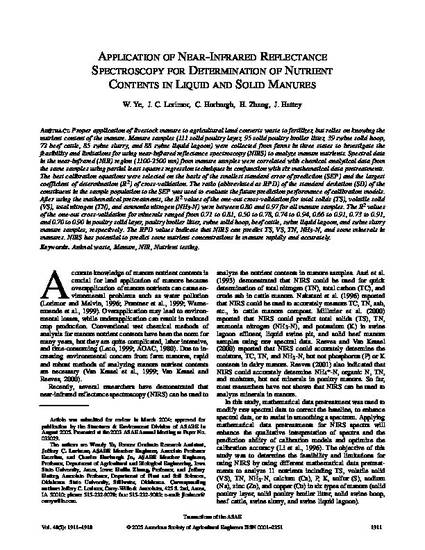
Proper application of livestock manure to agricultural land converts waste to fertilizer, but relies on knowing the nutrient content of the manure. Manure samples (111 solid poultry layer, 95 solid poultry broiler litter, 39 swine solid hoop, 72 beef cattle, 85 swine slurry, and 88 swine liquid lagoon) were collected from farms in three states to investigate the feasibility and limitations for using near-infrared reflectance spectroscopy (NIRS) to analyze manure nutrients. Spectral data in the near-infrared (NIR) region (1100-2500 nm) from manure samples were correlated with chemical analytical data from the same samples using partial least squares regression techniques in conjunction with six mathematical data pretreatments. The best calibration equations were selected on the basis of the smallest standard error of prediction (SEP) and the largest coefficient of determination (R2) of cross-validation. The ratio (abbreviated as RPD) of the standard deviation (SD) of the constituent in the sample population to the SEP was used to evaluate the future prediction performance of calibration models. After using the mathematical pretreatments, the R2 values of the one-out cross-validation for total solids (TS), volatile solid (VS), total nitrogen (TN), and ammonia nitrogen (NH3-N) were between 0.80 and 0.97 for all manure samples. The R2 values of the one-out cross-validation for minerals ranged from 0.71 to 0.81, 0.50 to 0.78, 0.74 to 0.94, 0.66 to 0.91, 0.73 to 0.91, and 0.70 to 0.90 in poultry solid layer, poultry broiler litter, swine solid hoop, beef cattle, swine liquid lagoon, and swine slurry manure samples, respectively. The RPD values indicate that NIRS can predict TS, VS, TN, NH3-N, and some minerals in manures. NIRS has potential to predict some nutrient concentrations in manure rapidly and accurately.
Available at: http://works.bepress.com/charles_hurburgh/22/

This article is from Transactions of the ASAE 48 (2005): 1911–1918. Posted with permission.